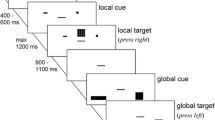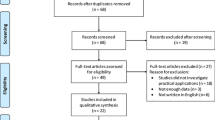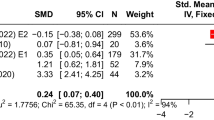Abstract
Binaural beats have been used as a way of modifying cognition via auditory stimulation. A recent meta-analysis suggests that binaural beat stimulation can have a positive effect on attention (Garcia-Argibay et al., Psychologische Forschung 83:1124–1136, 2019a, Psychological Research Psychologische Forschung 83:357–372, 2019b), with the sample-weighted average effect size being about .58. This is an intriguing and potentially useful finding, both theoretically and practically. In this study, we focus on sustained attention. We delivered beta-frequency (16 Hz) binaural beat stimulation during a sustained attention task. In “Experiment 1”, reaction times were faster under beat stimulation than control stimulation in a between-subjects design. However, the effect was modest in magnitude, and model comparisons using Bayes Factors were indiscriminate between including and excluding the effect from the model. We followed this initial experiment with two concurrently administered follow-up experiments. In “Experiment 2”, we added thought probes to measure any changes in task engagement associated with binaural beat stimulation. “Experiment 2” revealed a different effect from “Experiment 1”: participants in the binaural beat condition exhibited a shallower vigilance decrement. However, the beat stimulation did not affect the thought probes responses. Combining data across the two experiments indicated rather strong evidence against the hypothesis that beta-frequency binaural beats can augment sustained attention, either via a general speeding of responding or a mitigation of the vigilance decrement. Finally, in “Experiment 3”, we investigated whether pupillary measures of arousal and/or task engagement would be affected by binaural beat stimulation. There was no evidence for such effects. Overall, we did not observe any consistent evidence that binaural beat stimulation can augment sustained attention or its subjective and physiological correlates.







Similar content being viewed by others
Notes
As part of our preregistration for Experiment 1, we also stated that we would analyze the RTs with ex-Gaussian parameter estimates. Specifically, we extracted three parameters from the distribution of each individual’s RTs: µ, which represents the point of central tendency of the distribution, which represents the degree of variability in the distribution, and which represents the length of the tail of the distribution. In prior research with the psychomotor vigilance task, motivational incentives have been demonstrated to specifically affect µ (Brewer et al., 2017), whereas other experiments, like putting participants in acute pain have shown specific effects on \(\tau\) (Robison et al., 2021a). These results are reported for Experiment 1 to maintain the integrity of our preregistration.
The reported effect size is a bit larger than the effect size we used to perform the power analysis (d = 0.29) because we did not screen for outliers as stringently in our first analysis of the data as we did here.
Participants were run in groups (maximum size 8 participants), and signed up for the study ahead of time. We allowed participants who had signed up before we reached our cutoff to complete the study, and we retained their data.
A probe appeared every 16 trials. Because of the randomization of wait times, this meant a probe appeared roughly once every 100 s.
References
Adam, K. C. S., Mance, I., Fukuda, K., & Vogel, E. K. (2015). The contribution of attentional lapses to individual differences in visual working memory capacity. Journal of Cognitive Neuroscience, 27, 1601–1616. https://doi.org/10.1162/jocn_a_00811
Aust, F., & Barth, M. (2018). papaja: Create APA manuscripts with R Markdown. Retrieved from https://github.com/crsh/papaja. Accessed 4 June 2020
Bates, D., Mächler, M., Bolker, B., & Walker, S. (2015). Fitting linear mixed-effects models using lme4. Journal of Statistical Software, 67, 1–48. https://doi.org/10.18637/jss.v067.i01
Beatty, J. (1982). Task-evoked pupillary responses, processing load, and the structure of processing resources. Psychological Bulletin, 91, 276–292
Beauchene, C., Abaid, N., Moran, R., Diana, R. A., & Leonessa, A. (2016). The effect of binaural beats on visuospatial working memory and cortical connectivity. PLoS ONE, 11, e0166630
Beauchene, C., Abaid, N., Moran, R., Diana, R. A., & Leonessa, A. (2017). The effect of binaural beats on verbal working memory and cortical connectivity. Journal of Neural Engineering, 14, 026014
Brewer, G. A., Lau, K. K., Wingert, K. M., Ball, B. H., & Blais, C. (2017). Examining depletion theories under conditions of within-task transfer. Journal of Experimental Psychology General, 146, 988–1008
Crespo, A., Recuero, M., Galvez, G., & Begoña, A. (2013). Effect of binaural stimulation on attention and eeg. Archives of Acoustics, 38(4), 517–528
Dinges, D. F., & Powell, J. W. (1985). Microcomputer analyses of performance on a portable, simple visual rt task during sustained operations. Behavior Research Methods, Instruments, and Computers, 17, 652–655
Esterman, M., Grosso, M., Liu, G., Mitko, A., Morris, R., & DeGutis, J. (2016). Anticipation of monetary reward can attenuate the vigilance decrement. PLoS ONE, 11, e0159741
Esterman, M., Reagan, A., Liu, G., Turner, C., & DeGutis, J. (2014). Reward reveals dissociable aspects of sustained attention. Journal of Experimental Psychology General, 143, 2287–2295
Garcia-Argibay, M., Santed, M. A., & Reales, J. M. (2019a). Binaural auditory beats affect long-term memory. Psychological Research Psychologische Forschung, 83, 1124–1136
Garcia-Argibay, M., Santed, M. A., & Reales, J. M. (2019b). Efficacy of binaural auditory beats in cognition, anxiety, and pain perception: A meta-analysis. Psychological Research Psychologische Forschung, 83, 357–372
Goodin, P., Ciorciari, J., Baker, K., Carrey, A.-M., Harper, M., & Kaufman, J. (2012). A high-density eeg investigation into steady state binaural beat stimulation. PLoS ONE, 7(4), e34789
Hommel, B., Sellaro, R., Fischer, R., Borg, S., & Colzato, L. S. (2016). High-frequency binaural beats increase cognitive flexibility: Evidence from dual-task crosstalk. Frontiers in Psychology, 7, 1287
Hopstaken, J. F., van der Linden, D., Bakker, A. B., & Kompier, M. A. (2015a). The window of my eyes: Task disengagement and mental fatigue covary with pupil dynamics. Biological Psychology, 110, 100–106
Hopstaken, J. F., Van Der Linden, D., Bakker, A. B., & Kompier, M. A. (2015b). A multifaceted investigation of the link between mental fatigue and task disengagement. Psychophysiology, 52, 305–315
Hopstaken, J. F., van der Linden, D., Bakker, A. B., Kompier, M. A., & Leung, Y. K. (2016). Shifts in attention during mental fatigue: Evidence from subjective, behavioral, physiological, and eye-tracking data. Journal of Experimental Psychology Human Perception and Performance, 42, 878–889
Kennel, S., Taylor, A. G., Lyon, D., & Bourguignon, C. (2010). Pilot feasibility study of binaural auditory beats for reducing symptoms of inattention in children and adolescents with attention-deficit/hyperactivity disorder. Journal of Pediatric Nursing, 25, 3–11
Kraus, J., & Porubanová, M. (2015). The effect of binaural beats on working memory capacity. Studia Psychologica, 57, 135
Kurzban, R., Duckworth, A., Kable, J. W., & Myers, J. (2013). An opportunity cost model of subjective effort and task performance. Behavioral and Brain Sciences, 36, 661–679
Kuznetsova, A., Brockhoff, P. B., & Christensen, R. H. B. (2017). lmerTest package: Tests in linear mixed effects models. Journal of Statistical Software, 82(13), 1–26. https://doi.org/10.18637/jss.v082.i13
Lakatos, P., Karmos, G., Mehta, A. D., Ulbert, I., & Schroeder, C. E. (2008). Entrainment of neuronal oscillations as a mechanism of attentional selection. Science, 320, 110–113
Lane, J. D., Kasian, S. J., Owens, J. E., & Marsh, G. R. (1998). Binaural auditory beats affect vigilance performance and mood. Physiology and Behavior, 63, 249–252
Massar, S. A., Lim, J., Sasmita, K., & Chee, M. W. (2016). Rewards boost sustained attention through higher effort: A value-based decision making approach. Biological Psychology, 120, 21–27. https://doi.org/10.1016/j.biopsycho.2016.07.019
Massar, S. A., Lim, J., Sasmita, K., & Chee, M. W. (2019). Sleep deprivation increases the costs of attentional effort: Performance, preference and pupil size. Neuropsychologia, 123, 169–177
Massidda, D. (2013). Retimes: Reaction time analysis. https://CRAN.R-project.org/package=retimes. Accessed 4 June 2020
McVay, J. C., & Kane, M. J. (2012). Drifting from slow to “d’oh!”: Working memory capacity and mind wandering predict extreme reaction times and executive control errors. Journal of Experimental Psychology: Learning, Memory, and Cognition, 38, 525–549
Morey, R. D., & Rouder, J. N. (2018). BayesFactor: Computation of bayes factors for common designs. Retrieved from https://CRAN.R-project.org/package=BayesFactor
Reedijk, S. A., Bolders, A., Colzato, L. S., & Hommel, B. (2015). Eliminating the attentional blink through binaural beats: A case for tailored cognitive enhancement. Frontiers in Psychiatry, 6, 82
Robison, M. K. (2018). Regulating mind-wandering and sustained attention with goal-setting, feedback, and incentives. Doctoral Dissertation. Retrieved from http://hdl.handle.net/1794/23712
Robison, M. K., Miller, A. L., & Unsworth, N. (2019). Examining the effects of probe frequency, response options, and framing within the thought-probe method. Behavior Research Methods, 51, 398–408
Robison, M. K., & Unsworth, N. (2019). Pupillometry tracks fluctuations in working memory performance. Attention, Perception, and Psychophysics, 81, 407–419. https://doi.org/10.3758/s13414-018-1618-4
Robison, M. K., Ellis, D. M., Pitaes, M. M., Karoly, P., & Brewer, G. A. (2021a). Acute pain impairs sustained attention. Journal of Experimental Psychology: Applied
Robison, M. K., Unsworth, N., & Brewer, G. A. (2021b). Examining the effects of goal-setting, feedback, and incentives on sustained attention. Journal of Experimental Psychology: Human Perception and Performance
Solcà, M., Mottaz, A., & Guggisberg, A. G. (2016). Binaural beats increase interhemispheric alpha-band coherence between auditory cortices. Hearing Research, 332, 233–237
Thomson, D. R., Besner, D., & Smilek, D. (2015). A resource-control account of sustained attention: Evidence from mind-wandering and vigilance paradigms. Perspectives on Psychological Science, 10, 82–96
Thomson, D. R., Seli, P., Besner, D., & Smilek, D. (2014). On the link between mind wandering and task performance over time. Consciousness and Cognition, 27, 14–26
Unsworth, N., & Robison, M. K. (2016). Pupillary correlates of lapses of sustained attention. Cognitive, Affective, and Behavioral Neuroscience, 16, 601–615. https://doi.org/10.3758/s13415-016-0417-4
Unsworth, N., & Robison, M. K. (2017). The importance of arousal for variation in working memory capacity and attention control: A latent variable pupillometry study. Journal of Experimental Psychology: Learning, Memory, and Cognition, 43, 1962–1987. https://doi.org/10.1037/xlm0000421
Unsworth, N., & Robison, M. K. (2018). Tracking arousal state and mind wandering with pupillometry. Cognitive, Affective, and Behavioral Neuroscience, 18, 638–664. https://doi.org/10.3758/s13415-018-0594-4
Unsworth, N., & Robison, M. K. (2020). Working memory capacity and sustained attention: A cognitive-energetic perspective. Journal of Experimental Psychology: Learning, Memory, and Cognition, 46, 77–103
Warm, J. S., Parasuraman, R., & Matthews, G. (2008). Vigilance requires hard mental work and is stressful. Human Factors, 50, 433–441
Weinstein, Y. (2018). Mind-wandering, how do I measure thee with probes? Let me count the ways. Behavior Research Methods, 50, 642–661
Wickham, H. (2017). Tidyverse: Easily install and load the ’tidyverse’. https://CRAN.R-project.org/package=tidyverse. Accessed 4 June 2020
Wiemers, E. A., & Redick, T. S. (2019). The influence of thought probes on performance: Does the mind wander more if you ask it? Psychonomic Bulletin and Review, 26, 367–373
Acknowledgements
The data from Experiment 1 were collected as part of an Honors Thesis completed by author M.O. for the Barrett Honors College at Arizona State University. We would like to thank Stephen Goldinger for providing the eye-tracking equipment necessary to complete this project. Authors M.K.R., C.B., and G.A.B. were supported by National Science Foundation grant 1632327 during the data collection phases of this project
Author information
Authors and Affiliations
Contributions
The data from “Experiment 1” were collected as part of an Honors Thesis completed by author M.O. for the Barrett Honors College at Arizona State University. We would like to thank Stephen Goldinger for providing the eye-tracking equipment necessary to complete this project. Authors M.K.R., C.B., and G.A.B. were supported by National Science Foundation grant 1,632,327 during the data collection phases of this project.
Corresponding author
Additional information
Publisher's Note
Springer Nature remains neutral with regard to jurisdictional claims in published maps and institutional affiliations.
Rights and permissions
About this article
Cite this article
Robison, M.K., Obulasetty, M., Blais, C. et al. The effect of binaural beat stimulation on sustained attention. Psychological Research 86, 808–822 (2022). https://doi.org/10.1007/s00426-021-01524-3
Received:
Accepted:
Published:
Issue Date:
DOI: https://doi.org/10.1007/s00426-021-01524-3




